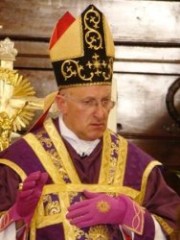24/10/2011
Bishop Rey: proposals for reform of the liturgical reform
 In the bimonthly "The New Man" of October 22, 2011 Father Claude Barthe writes an excellent record of the missionary work of the Bishop of Fréjus-Toulon, Bishop Dominique Rey. Addressing, among others things, the liturgical question, it states that the construction of the reform of the New Mass "is in the spirit of the motu proprio Summorum Pontificum , that is to say, for the sake of enriching mutual benefit of both forms of the Roman rite. But it has a long way to go to where first and foremost the sacrificial dimension inherent in the Eucharist Community dimension must be found together. "
In the bimonthly "The New Man" of October 22, 2011 Father Claude Barthe writes an excellent record of the missionary work of the Bishop of Fréjus-Toulon, Bishop Dominique Rey. Addressing, among others things, the liturgical question, it states that the construction of the reform of the New Mass "is in the spirit of the motu proprio Summorum Pontificum , that is to say, for the sake of enriching mutual benefit of both forms of the Roman rite. But it has a long way to go to where first and foremost the sacrificial dimension inherent in the Eucharist Community dimension must be found together. "
"This topic continues the bishop, actually covers many areas of thinking in different fields. In the future work of Joseph Ratzinger who became Pope Benedict XVI, we must remember that the traditional position of the priest at the altar during the offertory and anaphora can only foster a sense of worship and religious observance in the eucharistic celebration. This applies in both forms of the Roman rite. The Holy Father also gives the example of reclamation of communion on the tongue and kneeling if possible. (...) You may also wish a prominent place for the tabernacle, seen as an attempt of the real Presence, especially on the altar when it is still possible, as an attempt to educate the faithful of the faith in the Real Presence (cf. Sacramentum Caritatis, n ° 69).
"Moreover, we must recognize that the Roman texts, emphatically encourage the place of honor of the Latin language. Moreover, we see that this is not a problem for a number of parts of the celebration, and paradoxically younger generations have no knowledge a priori on this point.
"On the other hand, I hear priests wishing to celebrate in one and the other forms that require also as an important element of reconciliation desired by the pope to consider integrating ad libitum prayers of the traditional offertory, which could more easily be justified that these prayers are private and confidential. This deserves further in the direction of the reform of the reform discussion. Without falling into the ritualism of the secondary elements of the extraordinary form can perhaps help out the best sense of the sacred, such as signs of reverence of the priest vis-à-vis the Holy Sacrament.
"It seems to me that already the Roman Canon is used more in a number of major celebrations, as very strong sign of communion, both horizontally and vertically, with all our Roman tradition. And, similarly, the recovery of a "culture" of qulity ornaments and liturgical objects is well underway, especially among the young clergy. What should be connected with respect, in sacred architecture, "forms received by the Christian tradition" , to quote the old canonical norm.
"Conversely, the liturgical calendar of the extraordinary form should probably be updated to incorporate elements of the new calendar. Also enriching the "lectionary" in the extraordinary form could be welcome.
"All this, anyway, must mature patiently move smoothly and concern for communion. We must at the same time remain pragmatic attention to anything that promotes a strong sense of presence and the sacred, and consequently the spiritual and missionary vitality of our communities (...). "


No comments:
Post a Comment